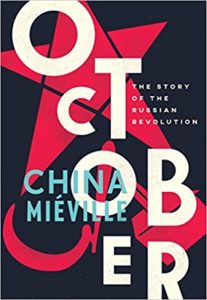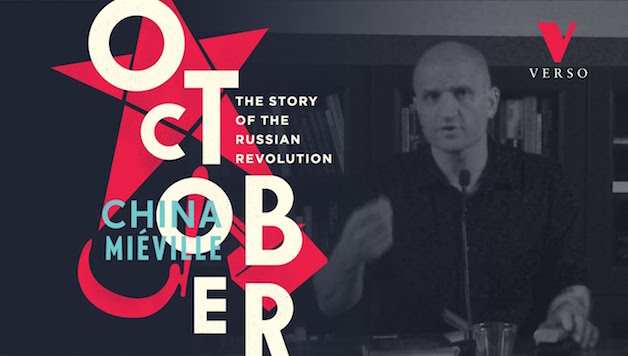Per-Åke Westerlund (first published in the Swedish socialist paper, Offensive)
 One hundred years after the Russian revolution shook the world, every socialist, anti-capitalist and militant will hugely profit from analysing those momentous events. A new book, ‘October’ by China Miéville gives good facts in defence of the revolution but also adopts a wavering position towards common slanders against Lenin and the Bolsheviks.
One hundred years after the Russian revolution shook the world, every socialist, anti-capitalist and militant will hugely profit from analysing those momentous events. A new book, ‘October’ by China Miéville gives good facts in defence of the revolution but also adopts a wavering position towards common slanders against Lenin and the Bolsheviks.
China Miéville’s book paints the picture of 1917 from February to October as a kind of light version of Trotsky’s classic History of the Russian Revolution. Facts are generally well chosen, and the narrative is adapted to today’s reader, for example on anti-racism and women’s rights.
He underlines the racism and anti-Semitism of the Tsar, as well as of the white counter-revolutionary forces from 1918 onwards. In the revolution in 1905, the Tsar launched the proto-fascist groups, the Black Hundreds. In contrast, “The socialist movement in the empire is always multi-ethnic, disproportionately comprising those of minority groups and nations.” He also describes, for example, the first All-Russian Muslim Conference in April 1917. The conference agreed on ten principles, including women’s right to vote, equality of the sexes, and “the non-compulsory nature of the hijab”.
Describing Lenin’s struggle to turn the Bolsheviks away from conciliationism after February, Miéville emphasises Alexandra Kollontai’s role in bringing Lenin’s ‘Letters from Afar’ to Russia in March. She also attacked any hesitation on the demand for women’s right to vote and played a leading role in the 40,000 women’s demonstration the same month.
However Miéville is obviously influenced by the historian Lars Lih’s position on Lenin, downplaying the degree of disputes between Lenin and the Bolshevik leadership in Russia during March and April. Miéville is actually taking two positions. He says Lenin’s Letters from Afar “horrified and stunned” the editors of Pravda but later Miéville describes the dispute as a “myth”. Miéville points at Trotsky “among others” as creators of this so-called myth, despite all the factual reports from Lenin’s struggle against the Bolshevik leadership on his return in April. Lenin’s position was to stress the need for the working class to take power, contrary to the conciliatory view towards the Provisional government of other Bolshevik leaders.
Miéville does make clear the Bolshevik’s proletarian base of support. After the February revolution, “The Mensheviks made it straight for the corridors of power; the Bolsheviks for the workers’ districts.” In May, the Bolsheviks had only ten delegates out of 1,200 at the first Peasant’s Congress, while they had two thirds of the workers at the Factory committee conference. This conference was the first major workers’ meeting to support the Bolshevik’s demand ‘all power to the soviets’.
The experiences of the masses under the Provisional government – regarding the war, land and national questions, poverty – and the actions of the Bolsheviks, made it possible for the Bolsheviks to eventually achieve mass support also among peasants and soldiers, who mainly were from rural areas. Miéville quotes the Menshevik, Sukhanov, on the defeat of General Kornilov’s attempted military coup in late August: “…the masses… were organised by the Bolsheviks”. He goes on, “With the Bolsheviks, the committee had at its disposal the full power of the organised workers and soldiers”.
July and post-October
Miéville’s book will undoubtedly have a good effect on new young readers. Its weakness is mainly on what happened after the working class took power in October under the leadership of the Bolsheviks. Even before, in his description of the July Days, Miéville wants to distance himself from the actions of the Bolsheviks. The situation in July was that many workers and soldiers in Petrograd felt strong enough to take power. The view of the Bolsheviks was that it was premature, there was not enough support in the rest of the country or among the mass of soldiers. The Bolsheviks therefore intervened, first to try to stop the armed demonstration, and when that failed, to limit it, to preserve the forces of the working class for future more favourable battles.
Miéville, however, seems to praise the action, in itself, saying no decisions to finish the demonstration should have been made: “as if there were a decision, or the party’s to make”. It was of course not an easy situation for a revolutionary party. The correctness of the position of the Bolsheviks can be noted in comparing July to October. In October, there was no need of mobilising armed masses to the streets. The Bosheviks had won over the overwhelming support needed amongst the masses, while the counter-revolution was collapsing. The qualitative leap, taking power, became a close to technical question of almost entirely peacefully taking control of the main institutions. In contrast, July was followed by massive repression. Miéville’s position on July reflects a lack of understanding on the need for an organised revolutionary party, its membership conscious of the tasks ahead, the key subjective factor in ensuring a revolutionary situation is grasped.
On the period following October, Miéville seems to have a determinist view on the destiny of Russia. Writing on the Soviet congress that decided to take power, he concludes: “But the war is not yet ended, and the order that will be constructed is anything but socialist. Instead, the months and years that follow will see the revolution embattled, assailed, isolated, ossified, broken. We know where this is going: purges, gulags, starvation, mass murder.”
It is true that Russia after October 1917 was not a socialist society, something Lenin stressed many times. But it is also true that the taking of power by the proletariat in Russia was the beginning of a series of revolutions. The Bolsheviks under Lenin and Trotsky never lost focus on the international socialist revolution. Victories in other countries, above all industrialised Germany, would have changed everything. Miéville’s readers will understand that the Russian revolution became isolated, but not why. The key lesson from 1917 and subsequent revolutions is the absolute need of a revolutionary party with the necessary experiences and roots, programme and actions. The Bolshevik’s history of party building through struggles and debates was lacking in Germany, Austria, Hungary, Finland and other parts of Europe during revolutionary movements in the years after 1917.
Constituent Assembly
Instead, Miéville tries to find the roots of Stalinism in the decisions of the Bolsheviks, shown by his comments on the Constituent Assembly. “It is then suppressed. Worse soon to come.” He later writes about a need to acknowledge the new Bolshevik regime’s “failures and crimes”.
The decision to dissolve the Constituent Assembly was not about blocking some kind of “democracy”. It was to prevent a new “dual power”, in a situation where the working class had already taken power through the Soviets (mass councils of workers, peasants and soldiers).
The Constituent Assembly elections were a kind of ‘opinion poll’ in which the Bolsheviks got 9 million votes and won majority in Petrograd and Moscow, compared with, for example, the Menshevik’s 668,000 votes and the bourgeois Cadet party’s 1.8 million. The Socialist Revolutionaries became the biggest party with 16.5 million votes. Their candidates, however, were right-SR figures, selected long before the Left-SR became the majority of that party. The dissolution of the Assembly was a calm event that caused almost no reaction or protests.
The case of the suppression of Kronstadt, in 1921, was not a major issue at the time, but was raised by anarchists in the 1930s in order to counter Trotsky’s criticism of the anarchist leaders’ role in the Spanish revolution. Under extremely difficult conditions facing the young workers’ state, at the height of the civil war against the white armies and foreign invasion In reality, Kronstadt in 1921 could have served as a launching pad for the counter-revolution.
Miéville does not understand that the victory of the political counter-revolution of Stalin and the rising state bureaucracy was only possible through a long drawn-out civil war. His description of the crucial debates is superficial and almost neutral: “Between 1924 and 1928 the atmosphere in Russia grows more and more toxic, infighting in the party more bitter, the shifting of allegiances and cliques more urgent and dangerous.”
The importance of those debates was not primarily about the “atmosphere”, but their content: nationalism or internationalism, Bolshevism or Menshevism, bureaucracy or worker’s democracy. It was real Bolshevism, as represented by Lenin in his last years, and Trotsky and the Left Opposition that conducted a courageous struggle against the degeneration of Soviet Russia into a Stalinist dictatorship.


